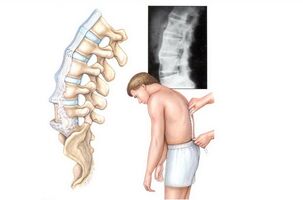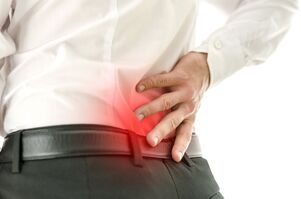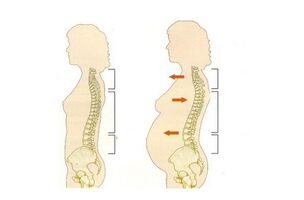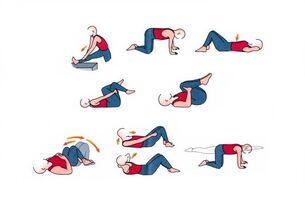Unfortunately, there are no absolutely healthy people in the world. Each of us periodically worries about something in the state of our own organism. This is perhaps why we most often wish each other health, well-being, complemented by a good mood.
Low back pain is one of the most common complaints. And, if in childhood it seemed to us that this concerned only the elderly, then, having matured, the awareness of the wrong opinion came. We are not insured against back pain by age, social status or type of activity. And this is due, first of all, to the variety of causes of pain in the lumbar spine, as well as its various manifestations.
Diseases that cause low back pain
Often pain in the lower back is caused by a specific disease and is a consequence - a symptom, the nature of which allows to carry out targeted diagnoses, make the correct diagnosis and indicate the means, methods, methods and, in general, tactics of treating the disease.

Pain in the lumbar region is primary or secondary.
Primary has a direct link with diseases of the spine:
- osteochondrosis or degenerative disorders of the articular cartilage (one third of the total number of patient visits);
- "bulging" of the intervertebral disc outside the limits of the spine (protrusion), displacement of the disc nucleus, in which the fibrous ring ruptures (intervertebral hernia);
- displacement of one or more vertebrae: forward, backward;
- accelerated aging and destruction of the cartilage of the intervertebral joints (spondyloarthrosis);
- growth of bone tissue along the edges of the spine in the form of spines (spondylosis).
Secondary pain is caused by diseases of other organs:
- vertebral fractures due to trauma or osteoporosis (increased brittleness of bones);
- the appearance of a tumor in one of the parts (lumen) of the spinal canal;
- muscle fatigue;
- congenital insufficient width of the spinal canal;
- all kinds of curvature of the spine and their combination, including deformities leading to the appearance of a "bump" in the thoracic spine;
- various types of arthritis / joint diseases (psoriatic, rheumatic and others);
- spinal tuberculosis and other inflammatory processes affecting the intervertebral discs;
- kidney / urinary tract stones, pyelonephritis (kidney damage);
- ovarian cysts, including cancers;
- Spinal pain is also possible as a complication of pregnancy in women.
What can the character of low back pain indicate?
Of course, it is impossible to independently diagnose the degree, level, type of back pain. But nevertheless, when the back hurts, certain specific symptoms indicate to us this or that disease.
Intense pain
When the pain in the lumbar spine is severe, the patient is very likely to have osteochondrosis or sciatica. In addition, in the first case, it manifests itself during walking, when a person sits for a long time, lifts weights, and also when coughing or sneezing. In some cases, one can complain that the back hurts and that this pain radiates to the leg.
If we talk about radiculitis, the patient describes the pain as sharp or dull, painful, often - it is one-sided and "responds" in the thigh, leg, buttock. It can increase with walking, with a change in the position of the human body, with a cough.
What Can Acute Lower Back Pain Indicate?
In cases where the pain is acute you should talk about:
- muscle stretching;
- long-term work in an uncomfortable position for the trunk;
- back pain after sleep due, again, to an awkward position of the body and staying there for a significant period of time;
- pain occurring when lifting or carrying weights, falling, banging or suddenly moving;
- hypothermia or prolonged exposure to a draft;
- also has the likelihood of lumbago (so-called lumbago), which is suffered by patients involved in heavy physical labor. In this case, the pain in the lower back may disappear within a few days, but it also happens that it lingers and accompanies a person for two weeks or more;
- displacement of intervertebral discs that occur in the lumbar part - often appear in connection with a fracture of the spine, with osteochondrosis, interaction with heavy objects (in particular, lifting them), performingheavy physical actions or as a result of surgery aimed at the spine.

The Painful Nature of Pain: What Is It About?
Painful pain (the patient can phrase it as "lower back" or "pulling lower back") - very often manifests itself in the inflammatory process of the lumbar muscles.
This disease appears as a result of hypothermia or sudden muscle tension / overexertion. In this case, the patient defines pain as pain that hinders the lumbar spine and is accompanied by sharp pain during movement.
Chronic and persistent low back pain
If the lower back hurts and even the patient himself can describe it as chronic, the diagnosis will likely be:
- deforming spondylosis - an increase in the amount of bone tissue in the spine due to the appearance of spinal-shaped growths along the edge of the vertebrae (manifests as severe back pain, especially in the lumbar region, which can combine numbness and / or weakness of the legs);
- disease of the vertebral joints - most often it has a chronic systemic character;
- diseases of a number of oncological diseases;
- metabolic disorder.
Pains without constant localization, in motion
One of the most difficult cases of identifying causative diseases is the pain that moves from time to time. At the same time, a person can be sure that the lower back hurts, although in fact the body is "cheating" on him, and the disease has crept into other organs.
These pains are often caused by diseases of the pelvic organs. The inflammatory process in the kidneys, diseases of the pancreas, colon can contribute to the appearance of pain in the lumbar spine, and it can also occur due to painful changes in bone tissue and tumors of a different nature.
Sometimes the painful condition of the lower back is confused with the pain that occurs in the shoulder blade area. However, these are still different types of pain and they are mainly associated with different diseases. So, pain in the shoulder blades, for example, indicates a stomach ulcer, myocardial infarction, intercostal neuralgia and even psychological problems in a person.

If you find it difficult to independently determine the area in which the pain occurs, and at the same time it is regular or acute, you should immediately consult a doctor!
Injuries resulting in lower back pain
Strangely enough, but very often the cause of pain in the lower back is an injury sustained by a person - for example, with a bruise of the back muscles or a sprain. A timely visit to a doctor is a guarantee of the correct diagnosis and the effectiveness of treatment.
In advanced cases there is a high probability of a complication, not excluding a severe curvature of the spine.
Particularities of back pain in women
“What are the specific causes of low back pain in women? ” - you ask. And we will answer that there are not so few. And men, in general, might thank the Creator for the fact that they just can't have those reasons.
Among the “provocateurs” of low back pain in women are:
- rules / rules;
- pregnancy;
- highlight.
In each of these cases, the pain may be of a different nature. Depending on the immediate cause, the characteristics of the female body, the degree of stress on the lower back during pregnancy, the age of the woman, her job, the type of professional activity - the pain manifests itself fromdifferent ways.
And the men?
In men, painful lower back syndrome is unfortunately quite common.
And there are enough reasons for it without the female component:
- stretching (muscle, accompanied by sharp pain);
- a fracture of the spine (after a person has fallen on their feet or when a man has been hit in the lower back), very often men suffer such injuries in car accidents;
- protrusion / bulging of the intervertebral disc or displacement of several intervertebral discs, when it begins to put pressure on the nerve roots, this pathology usually occurs and is diagnosed by an excessive degree of physical activity;
- growth of metastases of cancers of the genital organs in men, most often occurs after the age of 50; at the same time, the pain develops with a change in the degree of damage to the bone tissue, and it is so strong that it can only be stopped by taking special narcotics, pain relievers;
- spondyloarthrosis (when a nerve root or several roots are damaged in the area of the intervertebral canal);
- in the event that the painful manifestations radiate, they indicate the presence and development of prostate diseases, liver or kidney problems.
Risk factors: what can cause low back pain?
Unfortunately, we cannot insure ourselves against this or that disease. But in our power to study the risk factors - the most common causes of the onset of the disease, and to take measures to eliminate them (if possible) or at least partially neutralize their effect on the body.
The most common and pronounced risk factors for low back pain are:
- performing intensive training with great physical effort (gym), especially on the spine and lumbar column;
- sudden awkward movement;
- stay for a significant period of time at the same post (for example, people whose activities are related to driving a car, working at a computer, and even work in which a person is forced to standfor a long time - consultants in stores, pharmacists) in pharmacies, foremen of machines in factories, etc. );
- in the morning, the lower back can also hurt, which "says" that the mattress or pillow is not suitable for you, but they do not exclude the inflammatory process, which thus manifests itself symptomatically;
- work, which is based on great physical or psychological stress, stress can also be manifested by low back pain;
- As mentioned earlier, pregnancy and childbirth also increase the likelihood of lower back pain;
- High weight and lower back pain are also closely related, as the pressure force on a person's internal organs and spine depends on the total body weight.

When do you need medical attention?
Just as we hate getting sick, we hate going to doctors for help. There are many ways to independently identify the causes of diseases and their treatment. Of course, there are reasons for this belief.
But in the case of back pain I always want to make a difference: here you can lie down, receive medical treatment on your own, but here - without the help of a doctor, sometimes - urgent! - just not enough.
We can say unequivocally that if the pain is of a point nature, or if the cause of the pain is one of the reasons for the female line, then in principle you cannot panic, but wait, watchthe body, give it the opportunity to be at rest, do not overload.
If the pain does not persist and do not recur, then you have correctly established the cause and can do without medical intervention.
For lower back pain:
- are repeated systematically;
- pass and resume;
- are amplified;
- pain persists for more than three days;
- are repeated in the morning;
- you are injured and associate this with the appearance of pain in the lower back;
- feel pain in the lower back and leg (foot and leg) at the same time;
- or - the pain in the lower back is combined and with it the buttock and lower leg (thigh, leg, foot) and even the groin area become numb - this is a serious reason for a visiturgent to the doctor!

In any of the above cases, you do not need to guess, find out for yourself what causes the pain, ask yourself why your lower back hurts, but you should immediatelycontact a medical establishment. Without medical assistance, the situation may get worse, and treatment will take much more time and effort.
Remember that back pain, low back pain is not a case where one can joke or hope "at random" (deformations or displacements of intervertebral discs, for example, have never been corrected. by themselves).
Failure to timely diagnose pain in a person, as well as correct treatment, can lead to serious and complicated illnesses, lumbar surgery, and even lower body paralysis and disability.

























